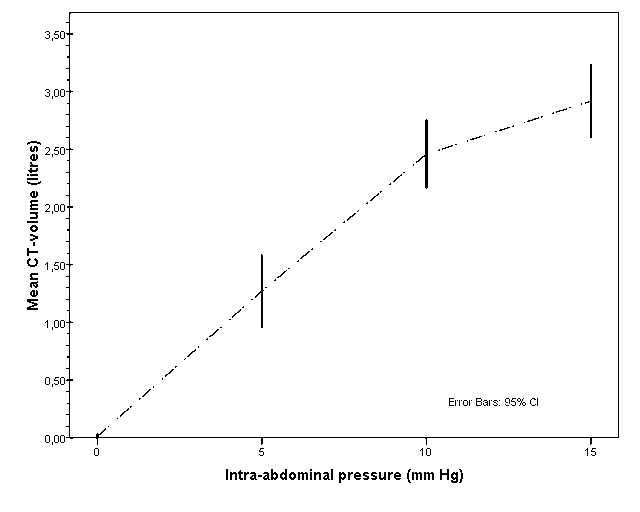John Vlot, MD, Rene Wijnen, PhD, Robert Jan Stolker, PhD, Klaas(n) M.a. Bax, PhD. Erasmus Medical Centre Rotterdam, Department of Pediatric Surgery and Department of Anesthsiology (R.J. Stolker), PO Box 2060 3000 CB Rotterdam, The Netherlands
INTRODUCTION – The effects of CO2 insufflation pressure on cardiorespiratory parameters and laparoscopic working space were analyzed in a porcine laparoscopy model using Computed Tomography (CT) for measuring intra-abdominal volume and distances.
METHODS AND PROCEDURES – Twelve non-starved pigs weighing approximately 20 kg were premedicated with midazolam and ketamine and kept anesthetized with propofol and sufentanil as a continuous intravenous infusion. No neuromuscular blocking agents were used. Ventilation was volume controlled (FiO2 40%, I:E ratio 1:2, tidal volume 10ml/kg, rate 40 /min, PEEP 5 cm H2O). Heart rate, respiratory rate, blood pressure, blood pH and pCO2, peak inspiratory pressure(PIP) and ETCO2 were recorded. End expiratory CT-scans at pneumoperitoneum pressures of 5, 10 and 15mm Hg were made. From reconstructed CT-images we measured intra-abdominal volume of CO2 as well as maximum antero-posterior(AP) distance of the abdominal cavity between the vertebral column and anterior peritoneum, maximum internal width and maximum cranio-caudal distance between the pubic symphysis and diaphragm. For statistical analysis paired T-tests for measurements at different levels of intra-abdominal pressure (IAP) were used. P< 0.05 was considered significant.
RESULTS – One pig died during surgical preparation, leaving data from 11 pigs for analysis. Ventilation rates were adjusted in 3 animals to compensate for hypercapnia. Other cardiorespiratory parameters remained stable except for a statistically significant increase of PIP at an IAP of 15mm Hg. A non-linear increase of volume with increasing IAP was found (Fig. 1). Only the internal AP-distance of the abdominal cavity increased significantly with increasing IAP(Fig. 2).
CONCLUSIONS – CT-analysis allows measurement of intra-abdominal working space volume and distances in laparoscopy. The gain in working space decreases rapidly at insufflation pressures above 10mm Hg IAP. Moreover, PIP increases significantly above an IAP of 10mm Hg. Only the AP distance increases significantly with increasing IAP. This model allows further investigation of the effects of other interventions aimed at increasing working space e.g. different ventilation strategies, neuromuscular blockade or bowel preparation.
Figure 1. Pressure-volume curve Figure 2. Pressure-distance curves
Session Number: Poster – Poster Presentations
Program Number: P018
View Poster


